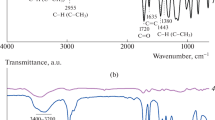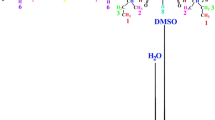Abstract
Thermo-oxidative stability of PMMA-grafted SiO2 and PMMA/PMMA-grafted SiO2 nanocomposites was investigated by conventional non-isothermal gravimetric technique. It was interesting to find that PMMA-grafted SiO2 nanoparticles exhibited higher thermo-oxidative stability than that of PMMA. The apparent activation energy of PMMA-grafted SiO2 nanoparticles increased with the grafting ratio of PMMA from SiO2, which was estimated by Kissinger method. This indicates that the strong interactions existing between the grafted chains are responsible for the enhanced thermo-oxidative stability of PMMA-grafted SiO2 nanoparticles. However, the grafting ratio of PMMA from SiO2 in nanoparticles has only limited effect on the thermo-oxidative stability of PMMA/PMMA-grafted SiO2 nanocomposites due to a much lower content of grafted PMMA in the nanoparticles relative to PMMA. The increased thermo-oxidative stability of PMMA/PMMA-grafted SiO2 nanocomposites is possibly resulted from the increased SiO2 content in the nanocomposites, in which the grafting ratio of PMMA in PMMA-grafted SiO2 nanoparticles is kept almost as a constant. The glass transition temperature (T g) of PMMA/PMMA-grafted SiO2 nanocomposites is about 25 °C and is higher than that of PMMA. The grafting ratio of PMMA from SiO2 in the nanoparticles has no qualitative effects on the T g of the nanocomposites.



Similar content being viewed by others
References
Mishra AK, Chattopadhyay S, Nando GB (2010) Effect of modifiers on morphology and thermal properties of novel thermoplastic polyurethane-peptized laponite nanocomposite. J Appl Polym Sci 115:558–569
Lafuente E, Pinol M, Martinez MT, Munoz E, Oriol L, Serrano JL (2009) Preparation and characterization of nematic polyazomethine/single-walled carbon nanotube composites prepared by in situ polymerization. J Polym Sci Part A: Polym Chem 47:2361–2372
Hong RY, Chen LL, Li JH, Li HZ, Zheng Y, Ding J (2007) Preparation and application of polystyrene-grafted ZnO nanoparticles. Polym Adv Technol 18:901–909
Zhong S, Meng Y, Ou Q, Shu X (2005) Plasma induced grafting of PSt onto titanium dioxide powder. II J Appl Polym Sci 97:2112–2117
Yang JM, Lu CS, Hsu YG, Shih CH (1997) Mechanical properties of acrylic bone cement containing PMMA-SiO2 hybrid sol–gel material. J Biomed Mater Res 38:143–154
Yang M, Dan Y (2006) Preparation of poly(methyl methacrylate)/titanium oxide composite particles via in situ emulsion polymerization. J Appl Polym Sci 101:4056–4063
Jiang L, Pan K, Zhang J, Dan Y (2008) Reverse atom transfer radical polymerization of MMA in the presence of CaCO3/SiO2 two-component composite particles. Macromol Symp 261:104–112
Kashiwagi T, Inaba A, Brown JE, Hatada K, Kitayama T, Masuda E (1986) Effects of weak linkages on the thermal and oxidative degradation of poly(methyl methacrylates). Macromolecules 19:2160–2168
Manring LE (1989) Thermal degradation of poly(methy1 methacrylate). 2. Vinyl-terminated polymer. Macromolecules 22:2673–2677
Hampsch HL, Yang J, Wong GK, Torkelson JM (1988) Thermal degradation of saturated poly(methy1 methacrylate). Macromolecules 21:530–532
Simon P, Zhong W, Bakos D, Hynek D (2008) Thermooxidative stability of polymethyl methacrylate containing nanoparticles of silica/titania and silica/zirconia. Chem Pap 62:176–180
Kuan HC, Chiu SL, Chen CH, Kuan CF, Chiang CL (2009) Synthesis, characterization, and thermal stability of PMMA/SiO2/TiO2 tertiary nanocomposites via non-hydrolytic sol–gel method. J Appl Polym Sci 113:1959–1965
Costache MC, Wang D, Heidecker MJ, Manias E, Wilkie CA (2006) The thermal degradation of poly(methyl methacrylate) nanocomposites with montmorillonite, layered double hydroxides and carbon nanotubes. Polym Adv Technol 17:272–280
Zhou HJ, Rong MZ, Zhang MQ, Ruan WH, Friedrich K (2007) Role of reactive compatibilization in preparation of nanosilica/polypropylene composites. Polym Eng Sci 47:499–509
Chaichana E, Jongsomjit B, Praserthdam P (2007) Effect of nano-SiO2 particle size on the formation of LLDPE/SiO2 nanocomposite synthesized via the in situ polymerization with metallocene catalyst. Chem Eng Sci 62:899–905
Kissinger HHE (1957) Reaction kinetics in differential thermal analysis. Anal Chem 29:1702–1706
Li CZ, Benicewicz BC (2005) Synthesis of well-defined polymer brushes grafted onto silica nanoparticles via surface reversible addition-fragmentation chain transfer polymerization. Macromolecules 38:5929–5936
Zhu J, Uhl FM, Morgan AB, Wilkie CA (2001) Studies on the mechanism by which the formation of nanocomposites enhances thermal stability. Chem Mater 13:4649–4654
Imoto M, Ohashi K (1968) Vinyl polymerization. Polymerization of methyl methacrylate initiated by methyl 1-methyl-2-(9′-anthryl)-cyclopropylcarboxylate. Makromol Chem 117:117–127
Ferington TE, Tobolsky AV (1955) Organic disulfides as initiators of polymerization: tetramethylthiuram disulfide. J Am Chem Soc 77:4510–4512
Zammit MD, Davis TP, Haddleton DM (1996) Determination of the propagation rate coefficient (kp) and termination mode in the free-radical polymerization of methyl methacrylate, employing matrix-assisted laser desorption ionization time-of-flight mass spectrometry for molecular weight distribution. Macromolecules 29:492–494
Chen K, Vyazovkin S (2006) Mechanistic differences in degradation of polystyrene and polystyrene-clay nanocomposite: thermal and thermo-oxidative degradation. Macromol Chem Phys 207:587–595
Acknowledgments
The authors thank the Tangshan Municipal Science and Technology Commission (No. 09150202A-3-2) and Tangshan Normal University (No.10B 04) for supporting this research program.
Author information
Authors and Affiliations
Corresponding author
Rights and permissions
About this article
Cite this article
Li, D., Su, G., He, Q. et al. Thermo-oxidative stability of poly(methyl methacrylate)/poly(methyl methacrylate)-grafted SiO2 nanocomposites. Polym. Bull. 71, 487–496 (2014). https://doi.org/10.1007/s00289-013-1072-3
Received:
Revised:
Accepted:
Published:
Issue Date:
DOI: https://doi.org/10.1007/s00289-013-1072-3




